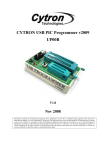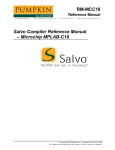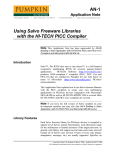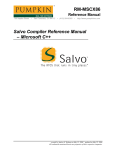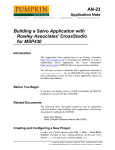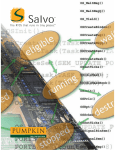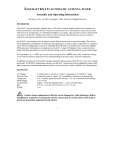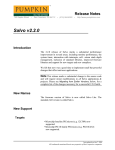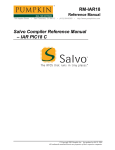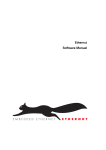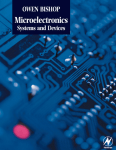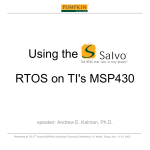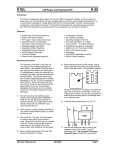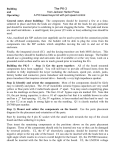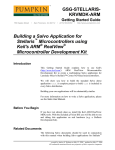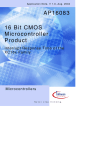Download RM-PICC Salvo Compiler Reference Manual – HI
Transcript
RM-PICC
Reference Manual
750 Naples Street
•
San Francisco, CA 94112
• (415) 584-6360
•
http://www.pumpkininc.com
Salvo Compiler Reference Manual
– HI-TECH PICC
© Copyright 2003 Pumpkin, Inc. last updated on Oct 16, 2003
All trademarks mentioned herein are properties of their respective companies.
Reference Manual
Introduction
This manual is intended for Salvo users who are targeting
Microchip
(http://www.microchip.com/)
PIC12|1400|16|17
PICmicro® MCUs with HI-TECH's (http://www.htsoft.com/)
PICC C compiler.
Related Documents
The following Salvo documents should be used in conjunction
with this manual when building Salvo applications with HITECH's PICC C compiler:
Salvo User Manual
Application Note AN-1 (obsolete)
Application Note AN-3
Application Note AN-4 (obsolete)
Application Note AN-9
Application Note AN-17
Application Note AN-26
Note PICC users are strongly advised to upgrade to Microchip's
MPLAB IDE v6.30. Use AN-26 in place of AN-1 and AN-4.
Example Projects
Example Salvo projects for use with HI-TECH's PICC C compiler
and the Microchip MPLAB IDEs v5 and v6 can be found in the:
\salvo\ex\ex1\sysa
\salvo\tut\tu1\sysa
\salvo\tut\tu2\sysa
\salvo\tut\tu3\sysa
\salvo\tut\tu4\sysa
\salvo\tut\tu5\sysa
\salvo\tut\tu6\sysa
\salvo\ex\ex1\sysh
\salvo\tut\tu1\sysh
\salvo\tut\tu2\sysh
\salvo\tut\tu3\sysh
\salvo\tut\tu4\sysh
\salvo\tut\tu5\sysh
\salvo\tut\tu6\sysh
2
RM-ICCAVR Salvo Compiler Reference Manual – HI-TECH PICC
Reference Manual
directories of every Salvo for Microchip PICmicro® MCUs
distribution.1
Features
Table 1 illustrates important features of Salvo's port to HI-TECH's
PICC C compiler.
general
available distributions
supported targets
header file(s)
other target-specific file(s)
project subdirectory name(s)
Salvo Lite, LE & Pro
for Microchip PICmicro® MCUs
PIC12|1400|16|17 PICmicro® MCUs
portpicc.h
-SYSA, SYSH
salvocfg.h
target-specific header file
required?
compiler auto-detected?
no
yes
2
context switching
label-based via
OSCtxSw(label)
yes
method
_OSLabel() required?
size of auto variables and
function parameters in tasks
unrestricted
interrupts
GIE / GLINTD bit
controlled via
interrupt status preserved in
critical sections?
method used
nesting limit
alternate methods possible?
no
interrupts disabled on entry and
enabled on exit of critical sections
no nesting permitted
3
yes
debugging
source-level debugging?
only in source-code builds
compiler
bitfield packing support?
printf() / %p support?
va_arg() support?
yes
yes / no
yes
Table 1: Features of Salvo Port to HI-TECH's PICC C
Compiler
RM-ICCAVR Salvo Compiler Reference Manual – HI-TECH PICC
3
Reference Manual
Compiler Optimizations
Incompatible Optimizations
No optimizations in PICC v8.02 or higher are known to be
incompatible with Salvo.
Libraries
Nomenclature
The Salvo libraries for HI-TECH's PICC C compiler follow the
naming convention shown in Figure 1. It is similar to that used by
HI-TECH for the standard PICC libraries.4
sfp42Cab.lib
Salvo library
type
f: freeware
l: standard
PICC
variant
a: fns called from anywhere
b: fns called from background only
f: fns called from foreground only
-: not applicable
configuration
a: multitasking with delays and events
d: multitasking with delays
e: multitasking with events
m: multitasking only
t: multitasking with delays and events,
tasks can wait with timeouts
target
PICmicro MCU (see table)
Figure 1: Salvo Library Nomenclature – HI-TECH's PICC
C Compiler
Type
Salvo Lite distributions contain freeware libraries. All other Salvo
distributions contain standard libraries. See the Libraries chapter of
the Salvo User Manual for more information on library types.
Target
Each library is intended for one or more specific processors. Table
2 lists the correct library for each PICmicro® MCU.
4
RM-ICCAVR Salvo Compiler Reference Manual – HI-TECH PICC
Reference Manual
target code
processor(s)
12C508(A), 12CE518, 16C52,
16C(R)54(A, B, C), 16HV540,
16C55(A)
16C(R)56(A)
12C(R)509(A, AF, AG), 12CE519
16C505
16C(R)57(A, B, C), 16C(R)58(A, B)
16C554(A), 16C556(A), 16C558(A),
16C(R)62(A, B), 16C620, 16C621,
16C622, 16C(R)64(A), 16C712,
16C715, 16C716, 16C(R)72(A)
16C61, 16C71, 16C710, 16C711,
16CR83, 16C(R)84, 16F83,
16F84(A)
12C671, 12C672, 12CE673,
12CE674, 16C432, 16C433,
16C620A, 16C621A, 16C622A,
16C641, 16C661, 16CE623,
16CE624, 16CE625
16C717, 16C770, 16C781, 16C782,
16F627, 16F628, 16F870, 16F871,
16F872
14000, 16C(R)63(A), 16C(R)65(A,
B), 16C73(A, B), 16(L)C74(A, B)
16F73, 16F74, 16F873(A),
16F874(A)
16C642, 16C662
16C771, 16C773, 16C774, 16C923,
16C924, 16C925
16C66, 16C67, 16C745, 16C76,
16C765, 16C77, 16F76, 16F77,
16F876(A), 16F877(A)
17C42(A)
17C42(A) with external ROM @
5
7000-7FFFh
17C(R)43, 17C44, 17C752, 17C762
17C756(A), 17C766
16C926
200:
210:
211:
212:
222:
401:
40a:
40b:
40c:
411:
412:
41b:
41c:
42c:
700:
710:
704:
714:
926:
Table 2: Processors for Salvo Libraries – HI-TECH's
PICC C Compiler
Verifying the Target Code
You can verify that you have chosen the right Salvo library by
observing the PICC C compiler's actions. Open the project's *.map
file and look towards the end of the Linker command line entry.
There, you will see which PICC library was used to build your
application. Use the same target code for your Salvo library.
For example, Listing 1 shows the linker command line entry for a
PICC project built for the PIC16F877:
RM-ICCAVR Salvo Compiler Reference Manual – HI-TECH PICC
5
Reference Manual
Linker command line:
-z -Mtu5lite.map -ol.obj \
ppowerup=00h,intentry=04h,intcode,intret,init,init23,end_init,clrtext,stringtable,ps
trings,strings \
-ABANK0=020h-07Fh -prbit_0=BANK0,rbss_0=BANK0,rdata_0=BANK0,idata_0=CODE \
-ABANK1=0A0h-0EFh -prbit_1=BANK1,rbss_1=BANK1,rdata_1=BANK1,idata_1=CODE \
-ABANK2=0110h-016Fh \
-prbit_2=BANK2,rbss_2=BANK2,rdata_2=BANK2,idata_2=CODE \
-ABANK3=0190h-01EFh \
-prbit_3=BANK3,rbss_3=BANK3,rdata_3=BANK3,idata_3=CODE \
-ACOMBANK=070h-07Fh -ptemp=COMBANK -ACODE=0-7FFhx4 -ACONST=0-0FFhx32 \
-pconfig=2007h -pidloc=2000h -AEEDATA=2100h-21FFh -peeprom_data=EEDATA \
-pfloat_text0=CODE,float_text1=CODE,float_text2=CODE \
-pfloat_text3=CODE,float_text4=CODE \
-pnvram=BANK0,nvram_1=BANK1,nvram_2=BANK2,nvram_3=BANK3 \
-pnvbit_0=BANK0,nvbit_1=BANK1,nvbit_2=BANK2,nvbit_3=BANK3 -Q16F877 -W-9 \
-h+tu5lite.sym -E -EC:\WINDOWS\TEMP\_3VVQHRP.AAA -ver=PICC#V8.02PL1 \
C:\HT-PIC\LIB\picrt42c.obj C:\salvo\tut\tu1\isr.obj C:\salvo\src\mem.obj \
C:\salvo\tut\tu5\main.obj C:\salvo\lib\htpicc\sfp42cab.lib \
C:\HT-PIC\LIB\pic42c-c.lib
Object code version is 3.7
Machine type is 16F877
Listing 1: Example Linker Command Line for PIC16F877
(from *.map file)
In this case, the PICC C compiler is linking to its pic42c-c.lib
library in order to build the application. Therefore the appropriate
target code for the Salvo library is 42c, e.g. sfp42cab.lib.6
Configuration
Different library configurations are provided for different Salvo
distributions and to enable the user to minimize the Salvo kernel's
footprint. See the Libraries chapter of the Salvo User Manual for
more information on library configurations.
Variant
Because PICmicro® MCUs do not have a general-purpose stack,
the Salvo source code must be properly configured via the
appropriate configuration parameters. The Salvo libraries for HITECH's PICC C compiler are provided in different variants as
shown in Table 3.
If your application does not call any Salvo services from within
interrupts, use the b variant. If you wish to these services
exclusively from within interrupts, use the f variant. If you wish to
do this from both inside and outside of interrupts, use the a variant.
In each case, you must call the services that you use from the
correct place in your application, or either the linker will generate
an error or your application will fail during runtime.
6
RM-ICCAVR Salvo Compiler Reference Manual – HI-TECH PICC
Reference Manual
variant code
a / OSA:
b / OSB:
f / OSF:
- / OSNONE:
description
Applicable services can be called
from anywhere, i.e. from the
foreground and the background,
simultaneously.
Applicable services may only be
called from the background (default).
Applicable services may only be
called from the foreground.
7
Library has no variants.
Table 3: Variants for Salvo Libraries – HI-TECH's PICC C
Compiler
See the OSCALL_OSXYZ configuration parameters for more
information on calling Salvo services from interrupts.
See Multiple Callgraph Issues, below, for more information on
using library variants.
Build Settings
Salvo's libraries for HI-TECH's PICC C compiler are built using
the default settings outlined in the Libraries chapter of the Salvo
User Manual. Target-specific settings and overrides are listed in
Table 4. Differences between the PIC12 and other families are due
to RAM constraints in the PIC12 series.
RM-ICCAVR Salvo Compiler Reference Manual – HI-TECH PICC
7
Reference Manual
compiled limits
PIC12
max. number of tasks
max. number of events
8
max. number of event flags
max. number of message
9
queues
3
5
1
0
1
target-specific settings
PIC12
delay sizes
idling hook
10
interrupt level
11,12
Salvo objects
system tick counter
task priorities
watchdog timer
PIC16, PIC17
3
4
1
8 bits
disabled
0
bank1 persistent
not available
disabled
cleared in
OSSched().
PIC16, PIC17
8 bits
enabled
0
bank1 persistent
available, 32 bits
enabled
cleared in
OSSched().
Table 4: Build Settings and Overrides for Salvo Libraries
for HI-TECH's PICC C Compiler
Note Because the
bank qualifier is used to build
these libraries,
used in all applications that use
these libraries. Without it, Salvo's variables will be uninitialized,
with unpredictable results.
persistent
OSInit() must be
Note PIC12, PIC16 and PIC17 Salvo libraries are configured for
8-bit message pointers (PICC's default pointer type). These
pointers can point to any area of banked RAM, but they cannot
point to ROM, i.e. they cannot be used with, say, const char
objects. To point to ROM, a source-code build with alternate
configuration options is required.
Note The compiled limits for tasks, events, etc. in Salvo libraries
can be overridden to be less (all Salvo distributions) or more (all
Salvo distributions except Salvo Lite) than the library default. See
the Libraries chapter of the Salvo User Manual for more
information.
Available Libraries
There are a total of 470 Salvo libraries for HI-TECH's PICC C
compiler (50 p2xx/PIC12, 300 p4xx/PIC16 and 120 p7xx/PIC17).
Each Salvo for Microchip PICmicro® MCUs distribution contains
the Salvo libraries of the lesser distributions beneath it.
8
RM-ICCAVR Salvo Compiler Reference Manual – HI-TECH PICC
Reference Manual
salvocfg.h Examples
Below are examples of salvocfg.h project configuration files for
different Salvo for PICmicro® MCUs distributions targeting the
PIC16F877.
Note When overriding the default number of tasks, events, etc. in
a Salvo library build, OSTASKS and OSEVENTS (respectively) must
also be defined in the project's salvocfg.h. If left undefined, the
default values (see Table 4) will be used.
Salvo Lite Library Build
#define OSUSE_LIBRARY
#define OSLIBRARY_TYPE
#define OSLIBRARY_CONFIG
TRUE
OSF
OSA
Listing 2: Example salvocfg.h for Library Build Using
sfp42cab.lib
Salvo LE & Pro Library Build
#define OSUSE_LIBRARY
#define OSLIBRARY_TYPE
#define OSLIBRARY_CONFIG
TRUE
OSL
OSA
Listing 3: Example salvocfg.h for Library Build Using
slp42cab.lib
Salvo Pro Source-Code Build
#define
#define
#define
#define
#define
OSENABLE_IDLING_HOOK
OSENABLE_SEMAPHORES
OSEVENTS
OSLOC_ALL
OSTASKS
TRUE
TRUE
1
bank1 persistent
3
Listing 4: Example salvocfg.h for Source-Code Build
RM-ICCAVR Salvo Compiler Reference Manual – HI-TECH PICC
9
Reference Manual
Performance
Memory Usage
tutorial memory usage13
tu1lite
tu2lite
tu3lite
tu4lite
tu5lite
tu6lite
tu6pro16
total ROM14
total RAM15
156
281
307
603
920
1026
942
22
26
28
34
51
56
52
Table 5: ROM and RAM requirements for Salvo
Applications built with HI-TECH's PICC C Compiler
Special Considerations
Stack Issues
For architectural reasons, HI-TECH's PICC C compiler does not
pass parameters on the stack. Nor does it allocate memory for auto
(local) variables on the stack. Instead, it employs a static overlay
model. This has advantages in speed and memory utilization, but it
precludes recursion and has other impacts.
Multiple Callgraph Issues
By default, it is expected that Salvo services will only be called
from the background / main loop / task level. This is the default
configuration for source-code builds. b-variant libraries allow
service calls only from the background level. Should you wish to
call certain services from the foreground / interrupt level, you will
need to set OSCALL_OSXYZ configuration options for source-code
builds or use a different library (see Table 3) for library builds.
From Variant, above, we find that the f-variant libraries allow you
to call event-reading and –signaling services from the foreground.
Similarly, the a-variant libraries allow you to call the applicable
services from anywhere in your code.
10
RM-ICCAVR Salvo Compiler Reference Manual – HI-TECH PICC
Reference Manual
The interrupt_level Pragma
When using the a-variant libraries, each instance of an applicable
service in use must be called from the foreground, i.e. from an
interrupt. Also, PICC's interrupt_level pragma must be set to 0
and placed immediately ahead of the application's interrupt routine,
like this:
#pragma interrupt_level 017
void interrupt IntVector( void )
{
OSStartTask(TASK_P);
}
Listing 5: Setting the HI-TECH PICC interrupt_level
Pragma for an ISR when Using a-variant Libraries
PICC requires this in order to manage the parameter overlay areas
for functions located on multiple call graphs.
Note This pragma has no effect if there aren't any functions
located on multiple call graphs. Therefore it's OK to add it to any
application compiled with PICC.
Example: Foreground Signaling of One Event Type
In a library build, if you were to move a call to OSSignalBinSem()
from a Salvo task (i.e. from the background) to an interrupt handler
(i.e. to the foreground) without changing the library variant, you'd
find that the application crashes from a stack overflow almost
immediately. This is because the default interrupt control18 in
OSSignalBinSem() is incompatible with being placed inside an
interrupt.
To
circumvent
this,
you
must
change
OSLIBRARY_VARIANT to OSF and link an f-variant library (e.g.
sfp42Caf.lib — note the f for foreground in the variant field) in
order to properly support event service calls in the foreground.
Example: Foreground and Background Signaling of One Event
Type
If we call OSSignalBinSem() from a task and from within an
interrupt handler without addressing the callgraph issues, the
compiler issues an error message:
Error[ ] file : function _OSSignalBinSem appears
in multiple call graphs: rooted at intlevel0 and
_main Exit status = 1
RM-ICCAVR Salvo Compiler Reference Manual – HI-TECH PICC
11
Reference Manual
To resolve this, add the interrupt_level 0 pragma to your
interrupt handler (see Listing 5, above) and use the a-variant
library after setting OSLIBRARY_TYPE to OSA.
OSProtect() and OSUnprotect()
HI-TECH's PICC C compiler requires that when a function is
contained in multiple callgraphs, interrupts must be disabled
"around" that function to prevent corruption of parameters and/or
return values.19 Therefore you must call OSProtect() immediately
before and OSUnProtect() immediately after all background
instances of every Salvo service that is called from both the
background and foreground levels, e.g.:
void TaskN ( void )
{
…
OSProtect();
OSSignalBinSem(SEM_P);
OSUnProtect();
…
}
#pragma interrupt_level 0
void interrupt IntVector( void )
{
OSSignalBinSem(SEM_P);
}
Example: Mixed Signaling of Multiple Event Types
The library variants affect all event services equally – that is, an fvariant library expects all applicable event services to be called
from the foreground, i.e. from within interrupts. If you wish to call
some services from the background, and others from the
foreground, you'll have to use the a-variant library, as explained
above.
A complication arises when you need an a-variant library for a
particular event type, and you also are using additional event types.
In this case, each instance of an applicable event service in use
must be called from the foreground. If it's not called from the
foreground, the compiler issue this error message:
Error[ ] file : function _OSSignalBinSem is not
called from specified interrupt level
Exit status = 1
12
RM-ICCAVR Salvo Compiler Reference Manual – HI-TECH PICC
Reference Manual
However, it need not be called from the background. If you have
the "opposite" situation, e.g. you are using an a-variant library for
one type of event and you need to call an event service for a
different event type only from the background, one solution is to
place the required foreground call inside an interrupt handler, with
a conditional that prevents it from ever happening, e.g.:
#pragma interrupt_level 0
void interrupt IntVector( void )
{
/* real code is here …
*/
…
/* dummy to satisfy call graph. */
if ( 0 ) OSSignalBinSem(OSECBP(1));
}
This creates a call graph acceptable to HI-TECH's PICC C
compiler and allows a successful compile and execution.
Interestingly, the optimizer will remove the call from the final
application.
1
2
3
4
5
6
7
8
9
10
11
12
13
14
15
16
17
The SYSH Salvo test system is for use with the Microchip MPLAB-ICD. This
debugging tool is not supported in MPLAB IDE v6, therefore the SYSH
projects are only for MPLAB IDE v5.
This is done automatically through the HI_TECH_C, _PIC12, _PIC14 and
_PIC16 symbols defined by the compiler.
The lack of an addressable stack severely limits the scope of alternate
methods.
As of PICC v7.87.
This indicates to the code generator that external memory in addition to
internal memory is present, and it will use (function) calls of a longer form.
See the PICC User's Guide for more information on the –ROM command-line
option.
Note that the PICC library is automatically added to the linker command line.
The Salvo library must be added manually by the user as part of setting up the
project.
A library may have no variants if the target processor does not support
interrupts.
Each event flag has RAM allocated to its own event flag control block.
Each message queue has RAM allocated to its own message queue control
block.
Argument for PICC's #pragma interrupt_level for those services that
can be called from within an ISR.
PICmicro MCUs with only one bank of RAM have their Salvo variables
located in RAM Bank 0.
By making Salvo's variables persistent, the PICC compiler is able to omit
some initialization code and thus reduce ROM requirements.
Salvo v3.2.0 with PICC v8.01PL3.
In words.
In bytes, all banks.
Salvo Pro build differs slightly from Salvo Lite build due to configuration –
see tutorial's salvocfg.h.
Salvo always uses level 0.
RM-ICCAVR Salvo Compiler Reference Manual – HI-TECH PICC
13
Reference Manual
18
19
14
OSSignalBinSem(), like many other user services, disables interrupts on
entry and (blindly) re-enables them on exit. The re-enabling of interrupts, if
placed inside a PICmicro interrupt routine, causes problems.
OSSignalBinSem() in the f- and a-variant libraries control interrupts
differently.
See PICC manual for more information.
RM-ICCAVR Salvo Compiler Reference Manual – HI-TECH PICC














